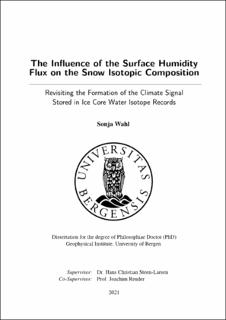| dc.contributor.author | Wahl, Sonja | |
| dc.date.accessioned | 2022-03-01T08:17:11Z | |
| dc.date.available | 2022-03-01T08:17:11Z | |
| dc.date.issued | 2022-02-24 | |
| dc.identifier.uri | https://hdl.handle.net/11250/2981923 | |
| dc.description.abstract | Accurate projections of future climate rely on knowledge of natural climate variability on different time scales. Climate proxies, such as stable water isotope records recovered from ice cores, provide insights into the climate variability of the past. A prerequisite for an accurate proxy-interpretation, however, is an in-depth understanding of the signal formation process capturing the climate signal in the isotopic composition of surface snow, which is buried and archived in the ice.
This thesis improves the understanding of how the climate imprints a signal on the snow isotopic composition. Specifically, the surface humidity flux, and the associated exchange of water isotopes between atmospheric water vapor and snow pack, is investigated as a potential process composing the isotope signal in the snow after deposition. First, in Paper I, we explore the vapor-snow exchange of stable water isotopes through in-situ isotope flux measurements taken in the interior of the Greenland Ice Sheet. For this, we developed a method that permits direct observations of the isotopic composition of the humidity flux. We find that the isotopic composition of the humidity flux is dependent on the snow and vapor isotopic composition during sublimation and deposition times, respectively. Additionally, we document isotopic fractionation during snow sublimation - a process that has been a subject of debate in the past and which is currently not implemented in isotope-enabled climate models.
Secondly, Paper II investigates the effect of sublimation on the isotopic composition of the snow. Based on laboratory experiments, we show that sublimation leads to an isotopic enrichment and an accompanying decrease in the d-excess value in the snow. The same is observed in field experiments, albeit less extreme, due to weaker sublimation fluxes. The study demonstrates that the snow surface isotopic composition is modulated on sub-daily timescales, documented through several high-temporal-resolution (3h) in-situ snow sampling experiments.
Paper III investigates the role of vapor-snow exchange on the temporal evolution of the isotope signal in the snow. For this, we set up a mass balance model of the snow surface system, forced with observations from two summers on the Greenland Ice Sheet. Three model simulations were performed with changing parameterizations for the sublimation process from kinetic and equilibrium fractionation to no fractionation. The isotopic composition of the deposition flux was parameterized with empirical functions of Paper I.We discover that the model can explain 35%and 52%of observed d 18O and dD variability in the simulation, including kinetic fractionation, whereas it fails when no fractionation is included. Furthermore, we find that the importance of vapor-snow exchange for the snow isotope signal is not constant throughout the observation period, with days with higher net sublimation having a greater impact on the snow isotope signal. The results motivate the realization of fractionation during snow sublimation in isotope-enabled climate models.
The three papers together form a holistic picture of a vapor-snow exchange that has the potential to imprint a climate signal in the snow. The relative importance of this process for the ice core isotope signal is variable in space and time, depending on the humidity flux magnitude within precipitation-free periods. Hence ice core isotope records might contain a continuous climate signal rather than a precipitation signal only. | en_US |
| dc.language.iso | eng | en_US |
| dc.publisher | The University of Bergen | en_US |
| dc.relation.haspart | Paper I: Wahl, S., Steen-Larsen, H. C., Reuder, J., and Hörhold, M. (2021). Quantifying the Stable Water Isotopologue Exchange Between Snow Surface and Lower Atmosphere by Direct Flux Measurements. Journal of Geophysical Research: Atmospheres 126/13. The article is available in the thesis. The article is also available at: <a href="https://doi.org/10.1029/2020JD034400" target="blank">https://doi.org/10.1029/2020JD034400</a> | en_US |
| dc.relation.haspart | Paper II: Hughes, A. G.,Wahl, S., Jones, T. R., Zuhr A., Hörhold, M., White, J. W. C. and Steen-Larsen, H. C. (2021). The Role of Sublimation as a Driver of Climate Signals in the Water Isotope Content of Surface Snow: Laboratory and Field Experimental Results. The Cryosphere 15. The article is available in the thesis. The article is also available at: <a href=" https://doi.org/10.5194/tc-15-4949-2021" target="blank"> https://doi.org/10.5194/tc-15-4949-2021</a> | en_US |
| dc.relation.haspart | Paper III: Wahl, S., Steen-Larsen, H. C., Hughes, A., Dietrich, L. J., Zuhr, A., Behrens, M., Faber, A.-K. and Hörhold, M. Challenging Old Axioms: Interpretations of Water Isotopes in Ice Cores. Not available in BORA. | en_US |
| dc.rights | Navngivelse 4.0 Internasjonal. This item's rights statement or license does not apply to the included articles in the thesis. | * |
| dc.rights.uri | http://creativecommons.org/licenses/by/4.0/deed.no | * |
| dc.title | The Influence of the Surface Humidity Flux on the Snow Isotopic Composition. Revisiting the Formation of the Climate Signal Stored in Ice Core Water Isotope Records | en_US |
| dc.type | Doctoral thesis | en_US |
| dc.rights.holder | Copyright the author. | en_US |

